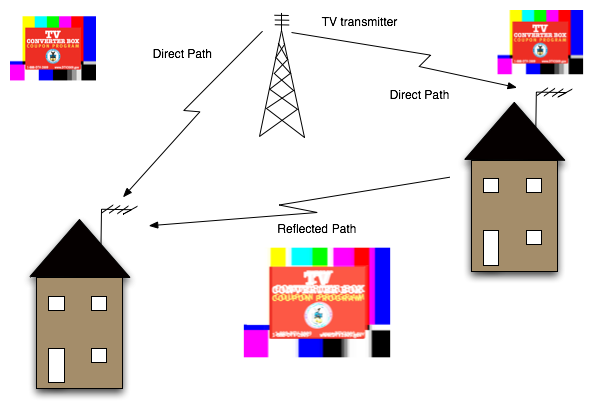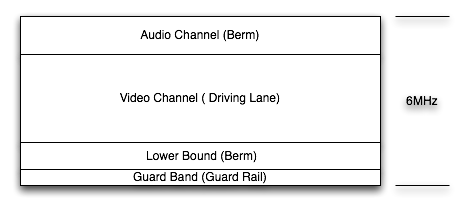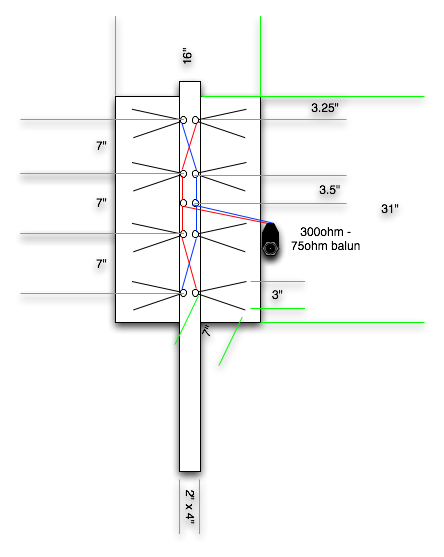With a little over 30 days to go till the big transition to Digital TV in America comes, it looks like there are going to be problems with the switch… The first, supposedly the people of America have failed to realize what they actually need to do for the transition. The second is that the government has ran out of money for the “coupons” to defer the cost of the converter boxes for the older TV’s that still exist. The third is the misinformation that is coming from various sources and the general misunderstanding of what is actually happening. So from a high tech person to hopefully the low tech people who still don’t understand, here is what is actually happening.
1. The airwaves (i.e. radio frequency) is a hot topic right now. The bandwidth (think of a analog TV channel as being road to drive a car on, and there are currently only 67 broadcast “roads”) being used by the current analog tv system is worth a lot of “money”. So the government has decided to sell off some of the bandwidth that is currently being used by TV to other services (cell, two-way radio, etc). With this change, there is a mandate that all TV (with the exception of Low Power TV stations for the moment) has to move to using a Digital Transmission system, instead of the current analog system. So what is the difference between the current analog and the new digital? One difference is picture quality. With digital, the picture is either 100% crystal clear, or you get no picture at all. As opposed to the old analog where you would get a “snowy” picture. In addition, there is no more “ghosting” (seeing more than one copy of the same image on the tv.) Ghosting is caused by the analog tv signal bouncing off of structures (buildings, mountains, planes, etc) and arriving at the TV set at different times.
Because of the signal arriving at the TV at different times, you will get multiple different versions of the image on the screen. With digital TV, this is avoided, as each frame of the TV signal is marked with a time stamp. When the TV is “showing” you the signal, if it receives a copy of a TV image that it has already shown, it silently discards it in to the “trash”, there by making the ghosting go away. Here is a quick picture of what ghosting is in analog tv:

Back to the highway term. With the current analog broadcast system, each TV channel is allocated 6MHz of bandwidth to broadcast their Video and Audio. Such as this:

So with only 67 “lanes” of TV channels, it limits what can actually be broadcast over the air. There are rules about how close 2 channels can be on the same frequency and on frequencies next to one and another. So most of the over the air channels have been limited to either National Networks, or other “Independent” stations. With the change to Digital transmission, it allows for each physical TV station, to broadcast more than 1 “channel” in their particular allotment of bandwidth. These other channels are called sub channels and each station can have up to 6 of them in their “road”. There by allowing much more content to be delivered over the air. One of the local channels WPXI, originally had their primary channel, and 2 sub channels in their allotment. The primary channel showed the same as what their analog channel 11 showed, but was in HD when the program source was in HD. The second channel 11.2 was a 24 hour a day weather channel. (Which they, NBC, have stopped broadcasting now.) Their third channel 11.3 shows the Retro TV Network. Some of the other Pittsburgh, Morgantown and Clarksburg channels are also using their sub carriers as well. PBS has 3 channels that they use. The interesting one is WBOY in Clarksburg. They are primarily a NBC affiliate, however there is no local ABC affiliate in the Clarksburg area, so they are using one of their sub channels 12.2 to broadcast ABC programming for the Clarksburg area. The FOX in Clarksburg uses one of their sub channels to broadcast the CW network to the local area.
2. So with the change to the digital broadcasting, more people are able to access more programming over the air, then they previously could. But with all good things comes bad things.
Most TV’s that have not been bought in the last couple of years, do not have a digital tuner in them. This means that all the new programming that is available over the air, can not be received with out a special set top box for the TV. In addition to the special box, you may need a new higher gain antenna than you previously had. The reason is most of the new digital channels are all in the UHF TV band. (As opposed to the VHF band where most of the current “big” channels are. ) The reason you need a higher gain antenna, is that because unlike with analog broadcasting where you might be able to see “part” of the picture even if it wasn’t completely clear, if you don’t have a good signal strength and quality of the digital signal you will not see a picture at all. So if you are watching analog TV over the air with an antenna, and the picture is a little fuzzy, you may be in need of a new high gain antenna, as more than likly the digital signal will not be strong enough for you. But back to the box now, because the government was mandating the change, they set aside money to provide people 2 $40 coupons to defer the cost of purchasing the boxes.
The problem with these coupons, they are only good for 90 days. So a lot of people have requested the coupons, but have not used them, and they have expired. This has caused the program to “run out of money”. So now when people go to the dtv2009.gov site, they can only be put on a wait list for the coupon. But considering that there is only 31 days left, the people who have not gotten their coupon’s will end up paying full price for their boxes. I almost was one of these people. I have requested the coupons but forgot till about 2 days before they expired that I had them. So I went to Radio Shack and bought two Zenith DTT901 boxes. The boxes have a nice guide interface and work good. But for them to work well, I needed an antenna. To see what I could possibly get with out buying an expensive high gain UHF antenna, I made one out of some stuff I had around the house. My “Antenna” is made out of a piece of 2×4, some stiff cardboard, heavy duty aluminum foil and some 12 guage electrical wire. The basic design looks like this:

Basically I wrapped the piece of card board with the aluminum foil. Then I tacked it to the back side of a 2 x 4 that was on it’s end. (tacked to the 2″ side). Then using some screws and washers I screwed in 10 screws with 3 washers each in to the other side of the 2×4. The first set of screws are about 3 inches from the top. Then the next set are 7 inches, 3.5, 3.5 and 7 inches. Next up was to take the 12 gauge wire, and cut 8 pieces that are 14 inches in length. Bend each piece at 7 inches, so that the ends are 3 inches apart. Those then get attached to the 2×4 with the screws/washers. Then take 2 more long pieces of 12 gauge wire and attach it as shown to all the screw posts, making sure to have the cross’ as shown. The final thing is to attach a 300ohm to 75ohm balun to the middle screws. This cheap antenna allowed me to get the local PBS channels and one of the Pittsburgh channels (Channel 4, which is on channel 51). I can also get some signal from some of the other channels, but not enough for them to actually come in. This could be fixed by a pre-amp, or adding another antenna to this one. This antenna is not meant for outside use either, as it would not stand up to any wind or other harsh elements, it is only meant to see if it is possible to pick up digital signals.
3. Finally the misinformation and general misunderstanding of what the actual digital switch is about. When any one asks me about the digital transition, I usually try to figure out what they currently do for television service and then base the answer on that. For example, my parents thought that the new HDTV broadcasts that are over the air, were going to be a for-pay service (ala cable, satellite). I told them that it was free and in the clear, just as it has always been. Other people think that even though they have cable or satellite that they have to get the new digital box just watch tv. For the most part this is false, but there has been some stuff going on in the cable world that is sort of making this true. See the cable companies are doing their own “digital conversion”. In the cable world, they use the same “roads” that the broadcasters use, but it is in a closed system. (Think of it as a toll road.) They also fall under the same problem that the analog broadcasters were. They can only show one channel per “road”. So they are starting to migrate most of all their channels to “digital” channels. This means that in the place that one analog channel is, there can be many digital channels (see Comcast morgantown lineup). This allows the cable company to supposedly give you more channels (of which some times there is nothing worth watching on). But with the move to digital, the cable companies are encrypting those channels, so people can not “pirate” cable and get access to something they shouldn’t have.. So what does this have to do with the digital conversion? Well now all those “cable ready” tv’s will start to become obsolete, and they will require addressable cable boxes in order to receive channels that you used to be able to receive with no cable box. It is also interesting that some cable companies are doing this switch around the same time as the over the air broadcast switch, and they are telling customers that it is a government mandate. This also means that the cable companies will more than likely start charging things differently now that they can block specific channels. It would be nice if they did have an a la carte pricing model, but I don’t see that happening any time soon.
In addition to the confusion, President-Elect Obama, is asking for a delay of the transition so that the public can be more prepared. Even West Virginia Sen. Jay Rockefeller, the new chairman of the Senate Commerce Committee, introduced legislation that would postpone the digital transition by almost four months. “I firmly believe that our nation is not yet ready to make this transition,” Rockefeller said in a statement. So how have other countries around the world handled the transition. I have been to a couple already that have made the switch, wonder what delays they had and how they handled it. But for right now, if you use cable, you shouldn’t need to worry. If you use satellite, you don’t need to worry. If you have bought a new tv in the last 2 years, you don’t need to worry. The only reason you should be worrying is if your tv is more than 3 years old, you use rabbit ears or a roof/attic antenna, and you haven’t purchased a digital tv box yet. Also remember if you have a VCR, it will need a box as well, or you will not be able to tape one show and then watch another at the same time, like you can now.
